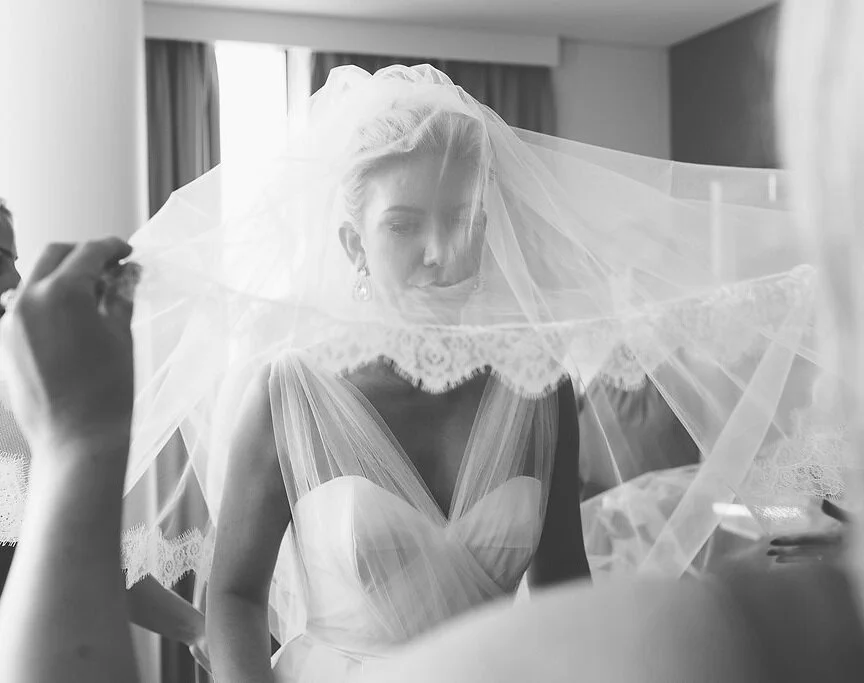To Veil or Not to Veil that is Always the Question.
What does a veil symbolise to you?
Many girls baulk at the idea of wearing a veil on their wedding day feeling unsure of its relevance in modern Australia. Most of them are not sure what a Bridal Veil symbolises and are uneasy about its perceived oppressive religious origins. So what are the true origins of this tradition and, is it as sexist or oppressive to women as we think?
I see many brides to be each year, and the veil question will inevitably arise at some point during our first consultation. If I were to put it into precise percentages, I would say that about 50% of my clients chose to wear a veil on their wedding day.
The underlying influence behind their decision tends to fall into one of two categories, Tradition and Style.
On the one hand, we have a young lady who has a clear vision of her wedding day and a good relationship with the traditions surrounding marriage. Wearing a bridal veil makes perfect sense to her.
On the other hand, we have a woman who knows her own personal style and a bridal veil is just another accessory that brings her whole look together.
To find out more about the long history and symbolism of the Bridal Veil, I have added a couple of links to great articles below.
Happy reading!
Jen x
p.s. I chose not to wear a veil on my wedding day simply because I wore blush and didn’t feel I needed one.
You can find pictures and testimonials from my past clients HERE.
Bridal Veils
The veil is one of the oldest parts of a bridal ensemble, dating as far back as Greek and Roman times, to hide a bride "from evil spirits who might want to thwart her happiness" or to frighten the spirits away. The veil also served to hide the bride's face from the groom prior to the wedding, as superstition says that it is bad luck for the groom to see the bride before the ceremony.
As weddings became more religious ceremonies in Western culture, the veil was used to symbolise modesty before God, obedience, and when the veil was white, chastity. By the 17th and 18th century, bridal veils were occasionally worn, but were generally out of fashion in Britain and North America, with brides choosing from many other options instead.
However, the bridal veil returned to popularity after Queen Victoria wore a veil in her wedding to Prince Albert in 1840. The bridal veil became a status symbol during the Victorian era, and the weight, length, and quality of the veil indicated the bride's social status. Bridal veils worn over the face were not common until the second half of the 19th century.
The tradition of a veiled bride's face continues today wherein, a virgin bride, especially in Christian or Jewish culture, enters the marriage ritual with a veiled face and head, and remains fully veiled, both head and face, until the ceremony concludes. After the full conclusion of the wedding ceremony, either the bride's father lifts the veil, presenting the bride to the groom who then kisses her, or the new groom lifts her face veil in order to kiss her. Some see the lifting of the veil as symbolically consummating the marriage, representing another thin membrane (the hymen) that will be physically penetrated on the wedding night.
In modern weddings, the lifting of the veil at the conclusion of the ceremony to present the bride to the groom may not occur, since it may be considered sexist for the bride to have her face covered through the ceremony, whether or not the veil is worn to symbolise virginity. Often the veil is worn solely as a fashion accessory as part of the bridal attire, instead of for its symbolism.
Wedding Veil Traditions Explained
Liz Susong (for Brides Magazine), weighs in on why brides traditionally wear a veil.
by Liz Susong
Need a Veil?
JGD always stocks a selection of Bridal Veils that are available to purchase off the rack. You can also order veils in many colours tulles and styles online, including:
- Elbow Length (to the elbow)
- Fingertip (to the fingertips)
- Waltz (to mid-calf)
- Chapel (to the floor)
- Cathedral (about 50 to 80cm longer than your train)




